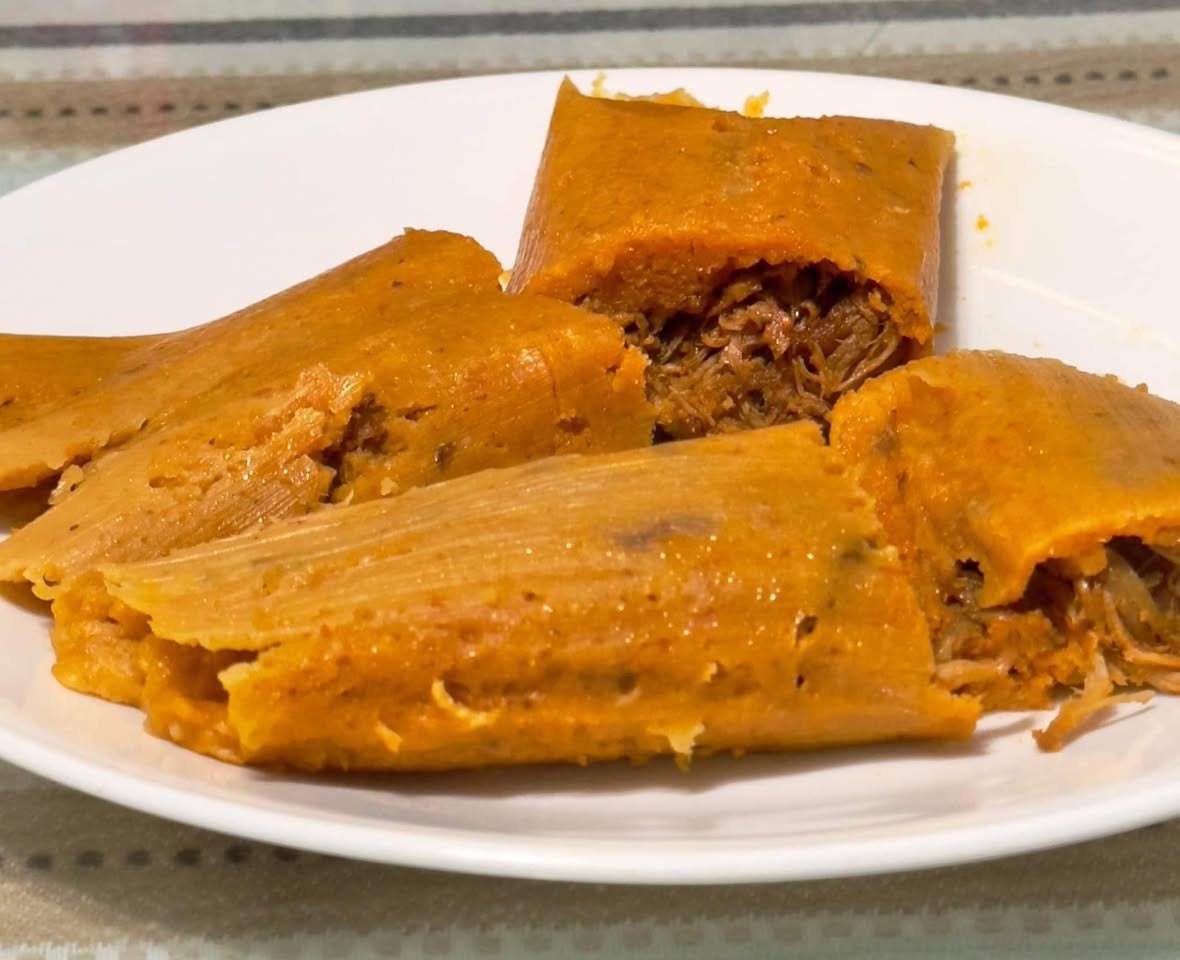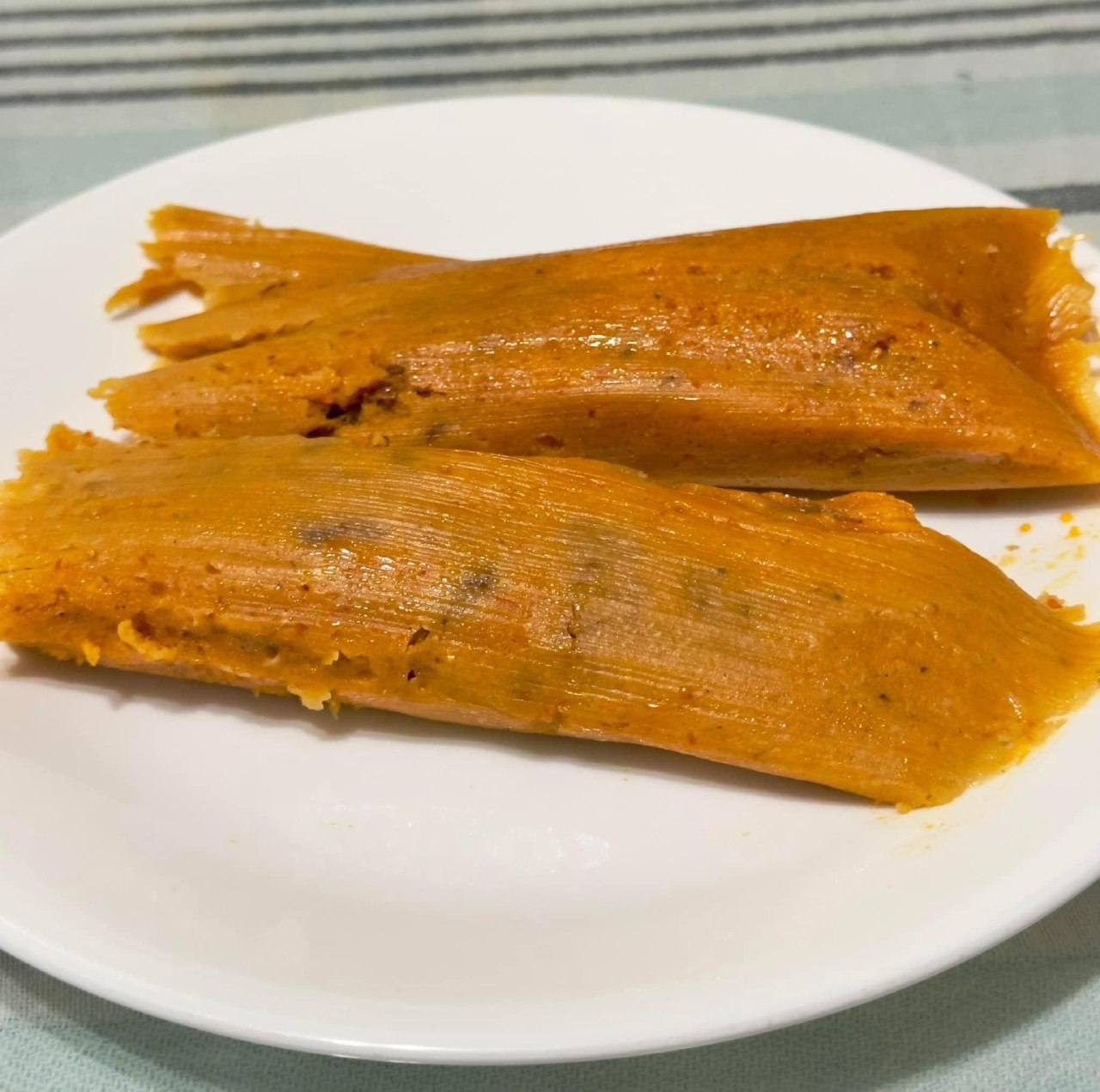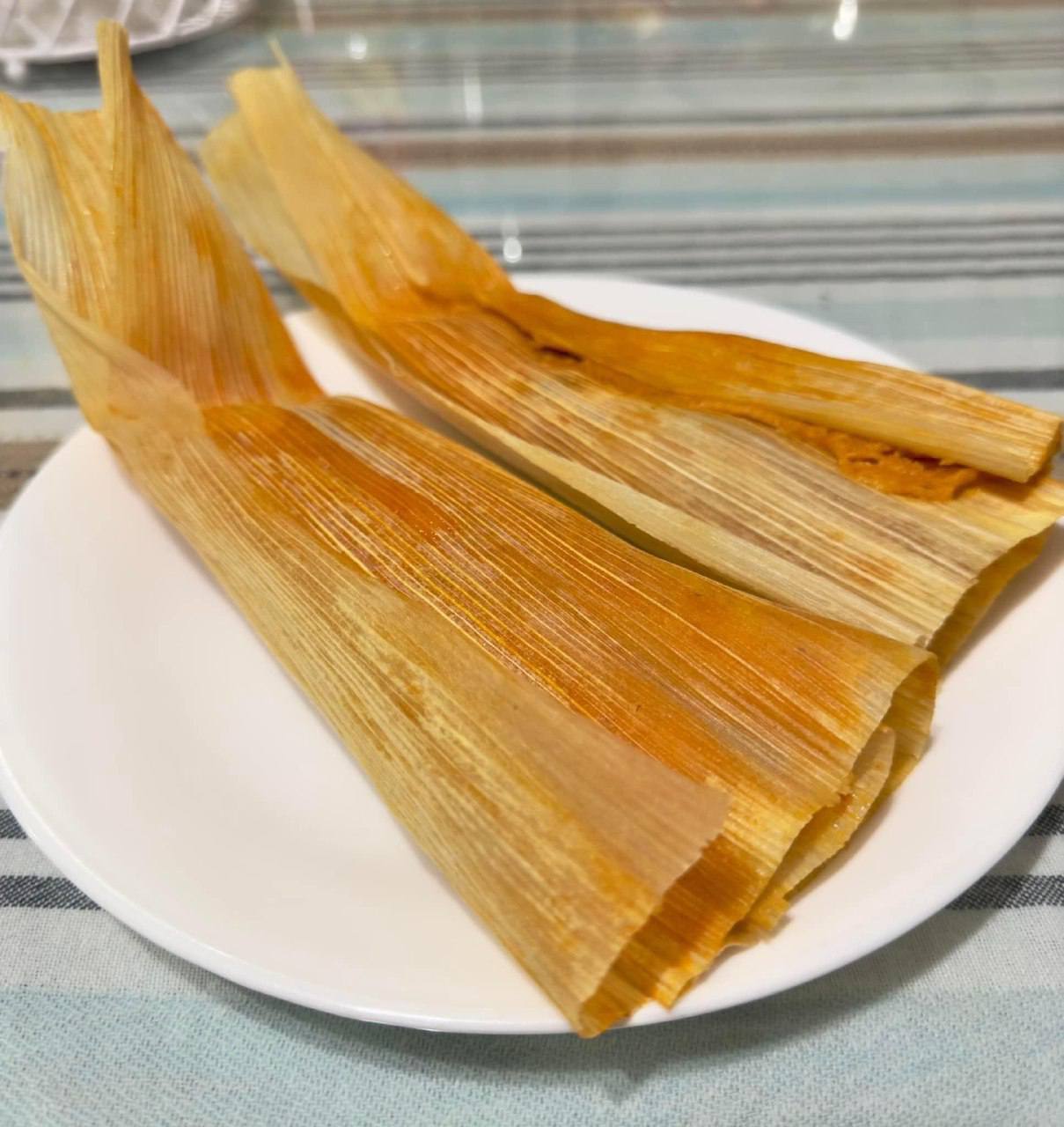Chile Colorado Tamales
Chile Colorado Tamales are a cherished dish in Mexican cuisine, known for their rich flavors and comforting presence. This recipe combines tender pork shoulder infused with a robust chile colorado sauce, all encased in a delicate masa dough and steamed to perfection.
Each tamale is a labor of love, starting with preparing the adobo sauce from dried ancho and guajillo chiles, enhancing the pork’s depth as it slow-roasts in the oven. The masa, enriched with lard and seasoned with baking powder, complements the savory filling, creating a harmonious blend of textures and tastes.
Wrapped in corn husks or banana leaves and steamed to tender perfection, these tamales are a culinary delight that celebrates traditional flavors and techniques. Enjoy them fresh or freeze for later, making them a versatile addition to any occasion.

Why People Will Love Chile Colorado Tamales:
Richly layered flavors – smoky dried chiles, tender pork, and fragrant spices come together in a harmony that is bold yet comforting.
Fluffy, soulful masa – whipped with chile colorado cooking liquid, the masa itself becomes infused with flavor, not just a wrapper but part of the experience.
A dish of tradition – each tamale carries centuries of culinary heritage, connecting eaters to Mexican culture, family gatherings, and festive celebrations.
Perfect balance of comfort and celebration – hearty enough for everyday nourishment yet elegant enough to grace holiday tables.
Made to share – tamales are crafted in abundance, meant to be unwrapped at the table, passed around, and enjoyed together, multiplying the joy of the meal.

Key Ingredient:
Ancho & Guajillo Chiles – the soul of the chile colorado, they bring a smoky sweetness, gentle heat, and a depth of flavor that defines the dish.
Pork Shoulder – slowly braised until tender and succulent, it absorbs the adobo’s spices and becomes the hearty core of each tamale.
Masa – not just a wrapper but the foundation, its soft, fluffy texture—enriched with chile-braised cooking liquid—carries flavor in every bite.
Lard (or shortening) – whipped into the masa, it creates lightness and richness, giving the tamale its signature airy structure.
Avocado & Hoja Santa Leaves (optional) – traditional herbs that add subtle earthy, anise-like notes, deepening the authenticity of the chile colorado.
Corn Husks or Banana Leaves – the natural wrappers that hold each tamale together, steaming them gently while infusing a rustic aroma.

Expert Tips:
Toast your chiles before soaking – a quick pass over a hot skillet or open flame awakens their oils, deepening the smoky, earthy flavor of the adobo.
Whip the masa with patience – beating the dough until it’s airy is key; a well-whipped masa will float a small piece in water, ensuring light, fluffy tamales instead of dense ones.
Taste and adjust as you go – both the chile colorado and the masa should be seasoned fully before assembling; under-seasoned masa can dull the vibrancy of the filling.
Seal and fold with care – overlapping the masa within the husk helps lock the filling in place, preventing leaks during steaming.
Mind the steam – keep water simmering steadily but not boiling violently. The rattling pennies will warn you if water runs low; refill carefully with hot water to avoid cooling the pot.
Rest before serving – allow tamales to sit briefly after steaming; this helps the masa firm up, making them easier to unwrap and more satisfying to eat.

How to make Chile Colorado Tamales
Ingredients:
For the chile colorado:
6 quarts (6 l) vegetable or beef stock
5 dried ancho chiles, stemmed and seeded
4 dried guajillo chiles, stemmed and seeded
1 yellow onion, quartered
4 garlic cloves
2 bay leaves
2 Tbs. dried oregano
1 1/2 tsp. ground cumin
1 tsp. smoked paprika
Kosher salt and freshly ground pepper
2 Tbs. cornstarch
3 lb. (1.5 kg) pork shoulder, excess fat trimmed, meat cut into 2-inch (5-cm) cubes
Avocado, grapeseed or vegetable oil for browning
2 avocado leaves (optional)
1 hoja santa leaf (optional)
For the tamales:
5 lb. (2.5 kg) fresh masa or 4.4 lb. (2.2 kg) masa harina
2 lb. (1 kg) lard or vegetable shortening, melted
2 tsp. baking powder
Kosher salt
11 cups (2.75 l) chile colorado cooking liquid
4 lb. (2 kg) dried corn husks or fresh banana leaves
Instructions:
To make the adobo, in a saucepan over medium-high heat, bring 2 cups (16 fl. oz./500 ml) of the stock to a simmer. Remove from the heat, add the chiles and soak until soft. Strain (reserve soaking liquid )and transfer the chiles to a blender. Add the onion, garlic, bay leaves, oregano, cumin and paprika and blend until smooth, adding as much of the soaking liquid as needed to achieve a smoothie-like texture. Strain the adobo to remove the chile skins, then season to taste with salt.
Preheat an oven to 320°F (160°C).
To make the chile colorado, in a large, shallow bowl, stir together the cornstarch, 2 Tbs. salt and 1 1/2 tsp. pepper. Dust the pork cubes with the cornstarch mixture.
In a large, oven-safe deep pan, warm some oil over medium-high heat. Working in batches as needed, sear the pork until golden brown. Return all of the pork to the pan, add the adobo, the remaining stock, and the avocado leaves and hoja santa leaf (if using). Cover the pan, transfer to the oven and roast until the pork is fork-tender, about 4 hours.
Transfer the pork to a large bowl, reserving the cooking liquid in the pan. Discard the leaves, if using. When cool enough to handle, shred the meat, then add enough cooking liquid to cover the pork. Reserve 11 cups (2.75 l) of the remaining liquid for the masa.
To make the masa, in the bowl of an electric mixer fitted with the paddle attachment, combine the masa, lard, baking powder and salt, to taste. Whip on medium-low speed until fluffy, 5 to 8 minutes, adding the cooking liquid 1 cup (8 fl. oz./250 ml) at a time. The mixture should be spreadable, not soupy, with a texture similar to polenta. Taste the masa and adjust the seasoning with salt as needed.
Fill a large bowl with boiling water and soak the corn husks until softened, 10 to 15 minutes. When the water is cool enough to touch, remove the husks and squeeze out the excess water. Place on paper towel–lined baking sheets. If using banana leaves, drag them over a gas flame to soften, then trim them.
Using a 4-oz. (125-ml) ice cream scoop, scoop a portion of the masa into a husk. Using an offset spatula, spread the masa across the square part of the husk so it is 1/4 inch (6 mm) thick, leaving an uncovered border on both sides. Fill the center with 4 oz. (125 g) of the chile colorado, adding an additional spoonful of the liquid over the meat. Fold one edge of the husk over the other to form a slender tamale. The overlapping masa will help to keep the tamale together. Next, fold the pointed husk over the tamale and lay it upright, with the seam up. Repeat with the remaining ingredients, reserving a few unfilled husks to use when steaming.
To steam the tamales, set a steam rack in a large pot and add enough water to reach the rack. Place 3 pennies in the pot (as the tamales steam, the pennies will rattle to alert you when the water is running out). Cover the rack with some of the reserved husks; this will help to prevent excess evaporation of water. Bring the water to a boil over high heat. Place the tamales upright, seam side up, in a circular pattern, layering additional husks between each layer. Reduce the heat to medium, cover, and steam the tamales for 1 to 1 1/2 hours. Remove a tamale from the pot and let it cool slightly, then check to see if the masa is cooked through. When the tamales are done, remove the pot from the heat and let the tamales cool to room temperature, then remove them with tongs.
The tamales can be wrapped individually in parchment paper and frozen. When ready to use, thaw in the refrigerator, then steam as directed or fry in thin layer of olive oil to reheat. Makes 30 to 40 tamales.

Important Notes When Making Chile Colorado Tamales:
Choose your chiles wisely – ancho brings mild sweetness, guajillo adds smoky fruitiness; together they balance depth and heat. Substituting one will shift the flavor, so use both for authenticity.
Fat equals flavor and texture – lard gives masa its traditional richness and airy softness. Vegetable shortening works as a substitute, but the depth of flavor will be different.
Masa consistency matters – it should be spreadable but not runny, similar to soft polenta. Too dry and it cracks when steaming; too wet and it won’t set properly.
Husks or leaves are not just wrappers – corn husks give a rustic, earthy aroma, while banana leaves add subtle smokiness. Either choice influences the final flavor.
Seasoning cannot be skipped – both the chile colorado and the masa need enough salt to carry flavor; bland masa will mute the entire dish no matter how good the filling is.
Tamales require patience – rushing the process leads to uneven cooking. Steaming is slow but ensures the masa cooks gently, firming up without drying out.
Storage wisdom – tamales freeze beautifully when wrapped individually. Steam or pan-fry in a thin layer of oil to reheat, which revives their aroma and texture.

How To Enjoy Chile Colorado Tamales After Cooking:
Let them rest briefly – once steaming is complete, allow the tamales to sit for 10–15 minutes; this helps the masa firm up, making them easier to unwrap and more satisfying to eat.
Unwrap with care – gently peel back the husk or banana leaf, breathing in the earthy aroma infused from the steam. This moment of reveal is part of the tamale ritual.
Notice the contrast – admire the fluffy masa surrounding the rich, brick-red chile colorado filling; the colors and textures tell the story of patience and tradition.
Take the first bite slowly – savor how the masa melts into the chile-braised pork, the smoky heat of the chiles balanced by the tender richness of the meat.
Pair thoughtfully – accompany with a drizzle of crema, a sprinkle of queso fresco, or a spoonful of salsa verde for added brightness. A side of Mexican rice or beans completes the experience.
Balance with a drink – enjoy alongside a cold Mexican lager, agua fresca, or a glass of horchata; the cooling sip enhances the depth of spice.
Share the tradition – tamales are rarely made in small numbers; they are crafted for gatherings, meant to be shared at the table, unwrapped together, and celebrated bite by bite.

Nutrition Information:
For 1 Tamale
Calories: 247 kcal | Protein: 10.5 g | Carbohydrates: 24.9 g | Fiber: 2.5 g | Sugars: 2.6 g | Fat: 11.9 g | Saturated Fat: 4.0 g | Cholesterol: 34 mg | Sodium: 758 mg

Frequently Asked Questions:
What is Chile Colorado?
Chile Colorado is a traditional Mexican sauce made from dried chiles, onions, garlic, and spices.
It is used as a base to flavor meats and tamales.
Can I use fresh chiles instead of dried for the adobo?
While dried chiles are typically used for their concentrated flavor, you can experiment with fresh chiles if desired.
Adjust the amount according to your taste preference.
What is the purpose of corn husks or banana leaves in making tamales?
Corn husks or banana leaves are used to wrap and steam the tamales.
They impart a subtle flavor to the masa and help keep the tamales moist during cooking.
How long does it take to prepare and cook Chile Colorado Tamales?
Preparation time varies, but cooking the tamales typically takes 1 to 1 1/2 hours after assembling them.
Allow additional time for preparing the adobo and masa.
Can I prepare tamales in advance?
Yes, tamales can be made ahead of time and frozen.
They should be wrapped individually in parchment paper before freezing.
Thaw them in the refrigerator overnight before reheating.
How do I know when the tamales are done steaming?
The masa should be cooked through and firm to the touch.
Test one tamale by removing it from the steamer and letting it cool slightly before checking the texture.
What can I serve with Chile Colorado Tamales?
Traditionally, tamales are served with Mexican rice, refried beans, and salsa.
Garnish with fresh cilantro and a squeeze of lime for added flavor.
Can I make the masa ahead of time?
Yes, you can prepare the masa ahead of time and store it in the refrigerator for up to 2 days.
Allow it to come to room temperature before assembling the tamales.
How do I reheat frozen tamales?
Thaw frozen tamales in the refrigerator overnight.
Steam them until heated through, or fry them in a thin layer of oil until crispy and heated.
Are there vegetarian options for Chile Colorado Tamales?
Yes, you can substitute the pork with vegetables or beans for a vegetarian version.
Adjust the seasoning and cooking time accordingly.